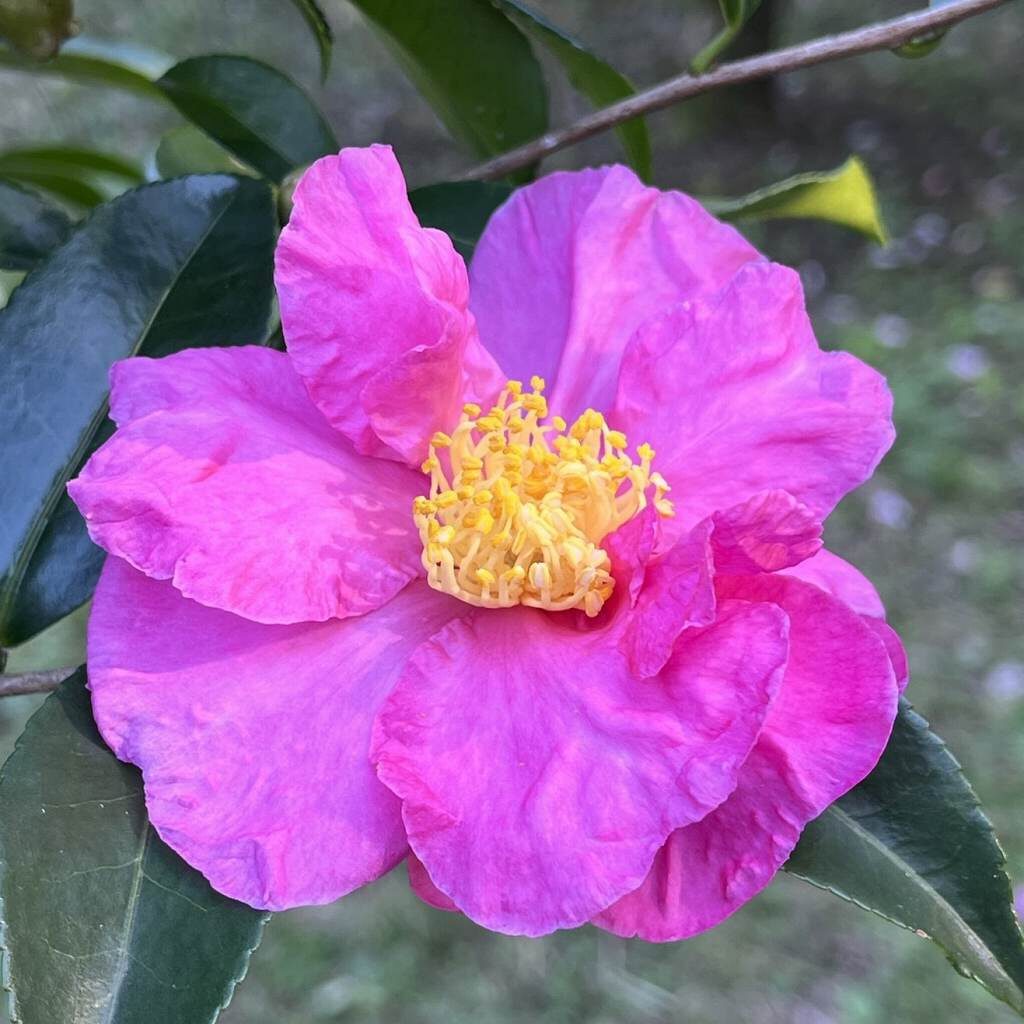サザンカの花は蜜を湛えて微かに甘く香ります。ツバキと違って葉の上に咲いて目立ち、花弁が薄く、花冠が全開。花弁は1枚ずつ散ります。
The Sasanqua flower is filled with nectar and has a faintly sweet scent. Unlike camellias, it blooms above the leaves and stands out, with thin petals and a fully open corolla. The petals fall off one by one.
【仮名】サザンカ
【和名】山茶花
【英名】Sasanqua
【学名】Camellia sasanqua
【誕生】11/ 03, 11/ 16, 11/ 17, 12/ 04
【開花】01, 02, 03, 04, 10, 11, 12月
【花色】White, Pink, Red






サザンカ
サザンカの来歴
サザンカはツバキ科の常緑樹です。原産地は日本で、本州の山口県、四国の南西部、九州の中南部、南西諸島などで自生。江戸時代に植物学者カール・ツンベルクが欧州に伝えました。花言葉は「謙遜」のほか、白色の花が「愛嬌」、桃色が「永遠の愛」、赤色が「最も美しい」など。
サザンカの名前
サザンカの和名は中国で椿類の花を意味する「山茶花」に由来。当初は「さんさか」と呼ばれ、それが「ささんか」となり、さらに現在の読み方へと転じました。ラテン語の属名カメリアは17世紀に東洋の植物を調べたチェコスロバキアの宣教師ゲオルグ・ヨーゼフ・カメルへの献名。
サザンカの姿形
サザンカの幹と枝は滑らかな褐色。葉は互生し、先の尖った楕円形で縁に鋸歯が入り、裏も表も光沢があって厚みがあります。花は蜜を湛えて微かに甘く香り、花弁が5~7枚、雄しべが多数、雌しべの柱頭が3裂。花後の蒴果は熟すと3つに裂けて中から黒褐色の種子が出てきます。
サザンカの品種
サザンカには大きく3つの系統があります。山茶花から育成された山茶花系は「七福神」「桜月夜」などの品種があり、10~12月に開花。山茶花と椿の交配によって作られた寒椿系は「獅子頭」「乙女」などで11~3月、春山茶花系は「梅ケ香」「笑顔」などで12~4月に開花します。
サザンカの近縁
サザンカとツバキは同属であり、姿形がよく似ています。山茶花は花が葉の上に咲いて目立ち、花弁が薄く、花冠が全開。花後は花弁が1枚ずつ散ります。一方、椿は花が葉の下に咲いて目立たず、花弁が厚く、花冠が半開。香りに乏しく、雄しべが筒状で、花後は花首ごと落ちます。
Sasanqua
Sasanqua is an evergreen tree of the Theaceae family. Originating in Japan, it grows wild in Yamaguchi Prefecture on Honshu, southwestern Shikoku, central and southern Kyushu, and the Nansei Islands. Botanist Carl Peter Thunberg brought it to Europe in the Edo period. In the language of flowers, in addition to “modesty”, the white flower is “charming”, the pink one is “eternal love”, and the red one is “the most beautiful”.
The Japanese name of Sasanqua comes from the Chinese word for camellia flower, means “mountain tea flower”. It was originally called “Sansaka”, then changed to “Sasanka”, and then changed to the current reading “Sazanka”. The Latin genus name Camellia was named after Czechoslovak missionary Georg Joseph Kamel, who studied oriental plants in the 17th century.
The stem and branches of the Sasanqua are smooth brown. The leaves are alternate, elliptical with pointed tips, serrated on the edges, glossy and thick on both sides. The flower is filled with nectar and has a faintly sweet fragrance. It has 5 to 7 petals, many stamens, and 3 lobed pistils. After flowering, the capsule splits into three when ripe, and dark brown seeds come out from inside.
There are three main strains of Sasanqua. The Sasanqua lineage was improved from Sasanqua, and there are varieties such as “Seven Gods of Fortune” and “Cherry blossom moonlit night”, which bloom from October to December. The Cold Camellia lineage was produced by crossbreeding Sasanqua and Camellia, such as “Lion head” and “Maiden”, which bloom from November to March. The Spring Sasanqua lineage ,such as “Scent of plum” and “Smile”, bloom from December to April.
Sasanqua and Camellia belong to the same genus, and their shapes are very similar. The Sasanqua flower blooms above the leaves and stands out. The petals are thin and the corolla is fully open. Tthe petals fall off one by one after flowering. On the other hand, Camellia flower blooms under the leaves and is inconspicuous, with thick petals and a half-open corolla. Poorly scented, the stamens are tubular, and the whole flower falls off after flowering.


